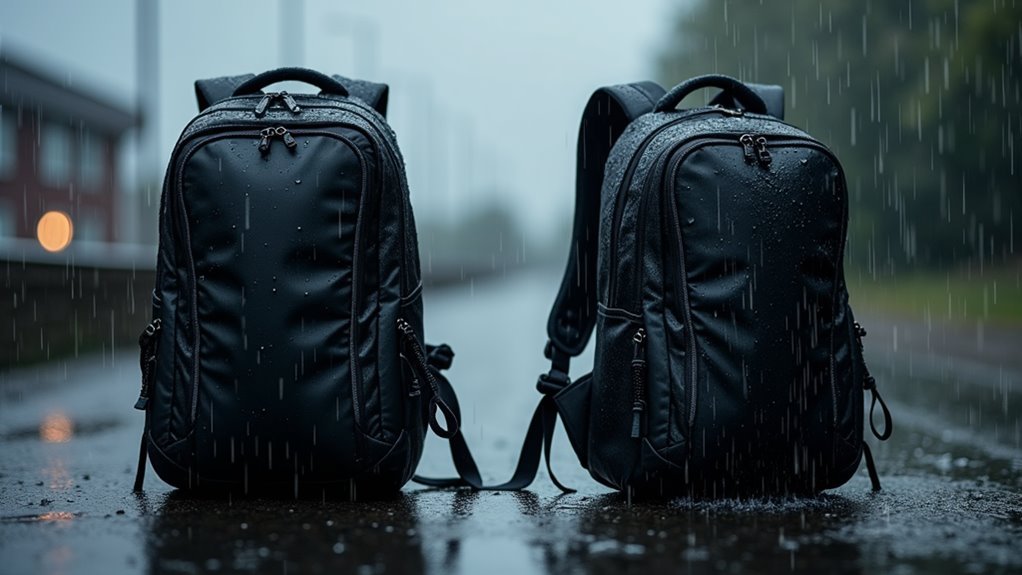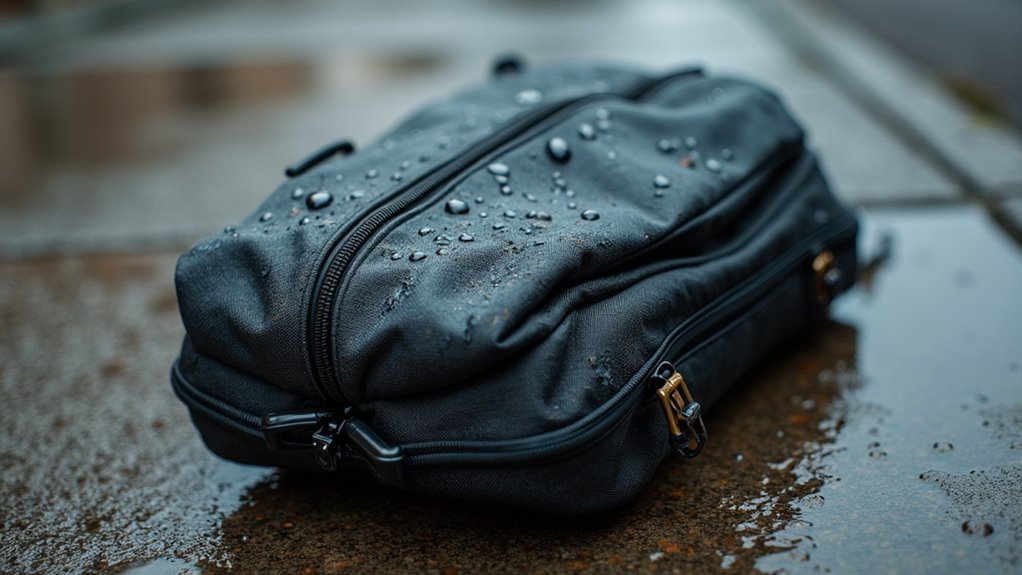Skateboard backpacks aren’t just regular bags with marketing hype—they’re actually designed with specialized attachment systems that keep your deck secure while maintaining proper weight distribution. I’ve found that heavy-duty materials like reinforced nylon and double-stitched stress points handle the abuse skating dishes out. Water-resistant coatings and sealed zippers protect your gear from light rain, though I think true waterproof protection requires more investment. Understanding these features helps you choose gear that’ll survive your sessions.
What Makes Skateboard Backpacks Different From Regular Backpacks

While most people grab any backpack off the shelf without much thought, skateboarders face a completely different set of challenges that regular backpacks simply weren’t designed to handle.
I think the biggest difference is how these bags secure your board. Regular backpacks? They’ll have you awkwardly carrying your skateboard in your hands or trying to strap it somewhere it doesn’t belong.
Skateboard backpacks feature dedicated attachment systems that keep your deck secure and balanced.
The weight distribution is perhaps more important than people realize. When you’re carrying a skateboard, regular bags throw off your center of gravity completely.
Built to Last: Materials and Construction Quality
Beyond the specialized features, you’re dealing with gear that needs to survive some pretty intense abuse.
I’ve seen too many regular backpacks fall apart after just a few months of skating sessions.
The materials matter here – thick nylon and high-density polyester aren’t just marketing speak. They actually resist tears when you’re crawling under fences or sliding along rough surfaces.
Heavy-duty fabrics like thick nylon and high-density polyester actually protect against real-world damage from crawling and sliding.
Double stitching makes a difference too, though I think the real test is those reinforced stress points where your board clips attach.
Perhaps most importantly, quality zippers won’t jam when you’re rushing to catch a session.
Understanding Water-Resistance Vs Waterproof Protection

Getting caught in the rain with your gear has taught me there’s an essential difference between water-resistant and waterproof that most people don’t really grasp until it’s too late.
Water-resistant means your backpack can handle light rain and splashes, perhaps for thirty minutes or so. Waterproof? That’s complete protection from water penetration.
Most skateboard backpacks offer water-resistance through coated materials and sealed seams. I think this works fine for unexpected drizzles, but don’t expect miracles during heavy downpours.
The marketing can be misleading sometimes, so I always check the specifications before buying.
Key Features That Keep Your Gear Dry
Although water-resistance varies between brands, there are specific features I’ve learned to look for that actually make a difference when you’re trying to keep your stuff dry.
The material coating is perhaps the most obvious one – I think you’ll notice how water beads up and rolls off quality backpacks rather than soaking in.
Beyond that, though, there are subtler details:
- Water-resistant zippers with sealed seams
- Reinforced stitching that doesn’t create weak points
- Storm flaps covering main compartments
- Welded seams instead of just sewn ones
These features work together, creating multiple barriers against moisture infiltration.
When Water-Resistance Falls Short: Knowing the Limits

Even with all these protective features, I’ve learned the hard way that water-resistance has its boundaries. During one particularly nasty downpour, my supposedly weather-ready pack let me down completely.
The thing is, most skateboard backpacks handle light rain and splashes just fine, but they’re not built for sustained soaking.
Water-resistant doesn’t mean waterproof – skateboard backpacks excel in light moisture but fail when truly drenched.
I think the biggest mistake we make is expecting too much from water-resistant materials. They work great for everyday moisture – perhaps a sudden drizzle or that inevitable splash from puddles.
But heavy rainfall? You’ll need a proper rain cover or you’ll be dealing with soggy gear.
Finding the Right Balance: Durability, Weather Protection, and Budget
When shopping for a skateboard backpack, I’ve realized that finding the sweet spot between quality, protection, and price isn’t as straightforward as I initially thought.
High-end models with premium materials can hit your wallet pretty hard, while budget options might leave you disappointed when caught in unexpected weather.
I think the trick is identifying which features actually matter for your skating style.
Consider these priorities when balancing your needs:
- Reinforced skateboard straps over fancy brand names
- Water-resistant zippers that actually work
- Durable base material where your board sits
- Practical pocket placement for your gear
Perhaps compromise on aesthetics but never on core functionality.
Frequently Asked Questions
Can I Wash My Skateboard Backpack in a Washing Machine?
I can wash most skateboard backpacks in machines, but I’ll check the care label first. I’ll use cold water, gentle cycle, and air dry to protect water-resistant coatings and prevent damage.
What Size Skateboard Fits in Most Skateboard Backpacks?
I’d say most skateboard backpacks accommodate the standard street-sized boards around 31-32 inches long. You’ll find they’re designed for typical deck widths too, giving you that unrestricted mobility every skater craves.
Do Skateboard Backpacks Work Well for Other Sports Equipment?
I’ve found skateboard backpacks work surprisingly well for other sports gear. Their durable construction, reinforced stitching, and water-resistant materials handle soccer cleats, basketball shoes, and gym equipment perfectly. You’ll appreciate their versatility beyond just skateboarding.
How Much Weight Can a Typical Skateboard Backpack Safely Carry?
I’d say most skateboard backpacks can safely handle 15-25 pounds, though you’ll want to check the manufacturer’s specs. The reinforced construction and balanced design help distribute weight effectively, so you’re not straining your back while skating.
Are There Skateboard Backpacks Specifically Designed for Longboards?
Ever wondered if your longboard deserves its own specialized carrier? I’ve discovered that yes, manufacturers create backpacks specifically engineered for longboards, featuring extended straps and reinforced attachment systems that accommodate their unique length and shape perfectly.
Conclusion
Finding the right skateboard backpack changed how I approach my sessions. I think it’s worth noting that quality packs can last 3-5 years with heavy use—that’s potentially thousands of skate sessions. Sure, you’ll pay more upfront, but I’ve learned that cheap bags fail when you need them most. Perhaps the investment seems steep initially, but reliable gear that protects your stuff and survives daily abuse? That’s honestly priceless for any serious skater.